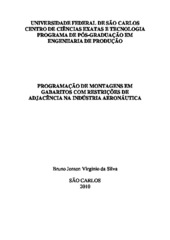Programação de montagens em gabaritos com restrições de adjacência na indústria aeronáutica

Ver/
Fecha
2010-12-03Autor
Silva, Bruno Jensen Virginio da
Metadatos
Mostrar el registro completo del ítemResumen
This work deals with a production scheduling problem that appears in the aeronautics industry, involving special structures called assembly fixtures, composed of several workstations in parallel to assemble parts of the aircrafts. Tasks should be scheduled to be performed in these workstations in order to minimize the quantity of manpower needed to do the assembly and determine the production capacity of the assembly fixture, which means minimizing the makespan (the total time needed to finish the tasks). However, in addition to the usual constraints such as due dates and precedence among tasks, there are also constraints that prevent two tasks to be performed at the same time in two adjacent workstations on the assembly fixture. The assembly and the teams who work there are in continuous improvement of assembling processes, according to the cumulative production increases and the learning curve is traversed. The learning curve was divided in four stages with specific characteristics in each. Mixed integer linear programming models are proposed to represent the production scheduling problem of each stage, based on practical cases studies of assembly fixtures scheduling in an aeronautics company. Those models are solved using a modeling language and optimization software. The solutions are analyzed and compared and based on then, it is evaluated how the learning curve affects the airplane production over time and it is shown, in the results, that there exists potential of improvement in the use of assembling resources, using production scheduling and levelling the resources.